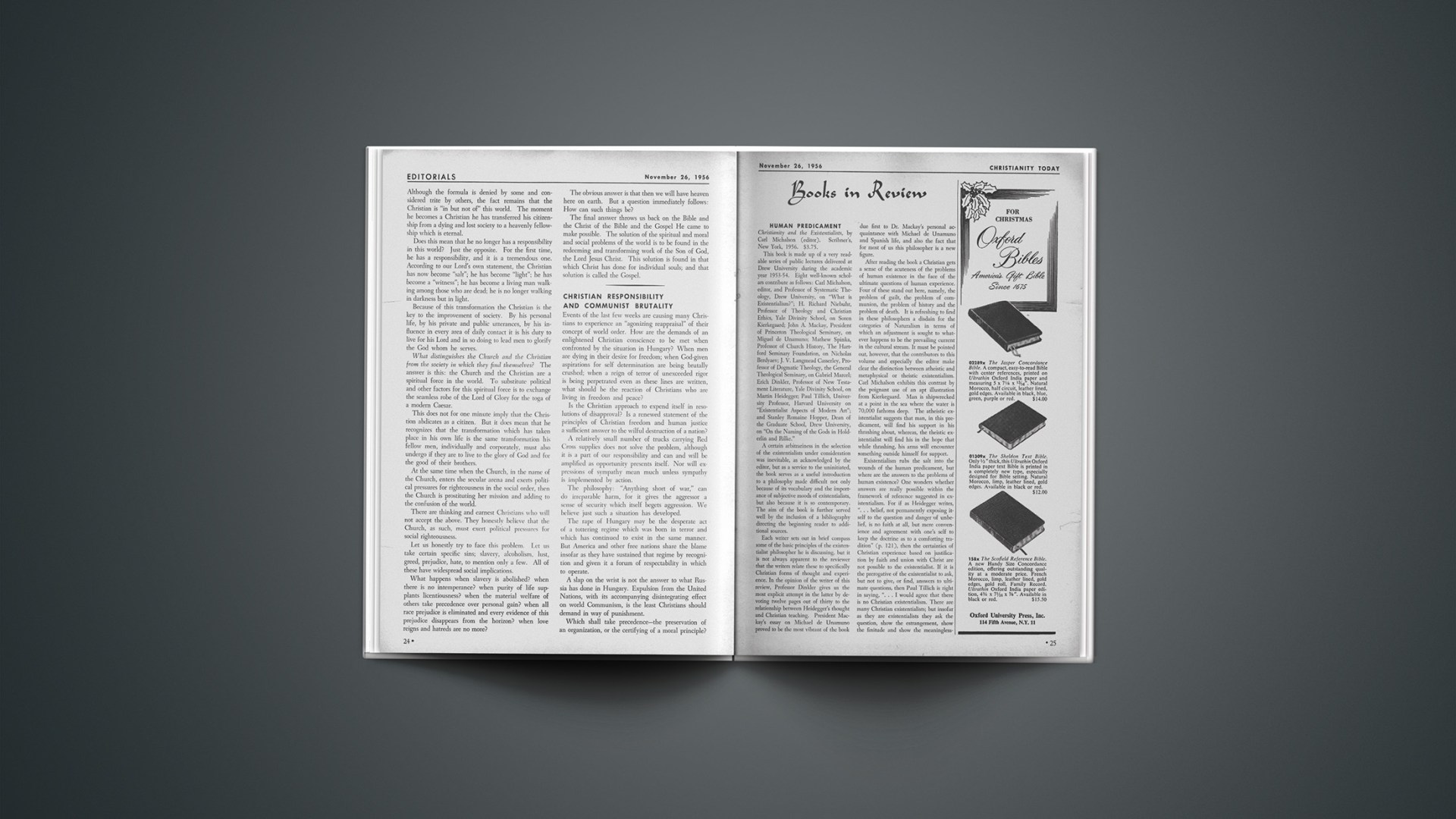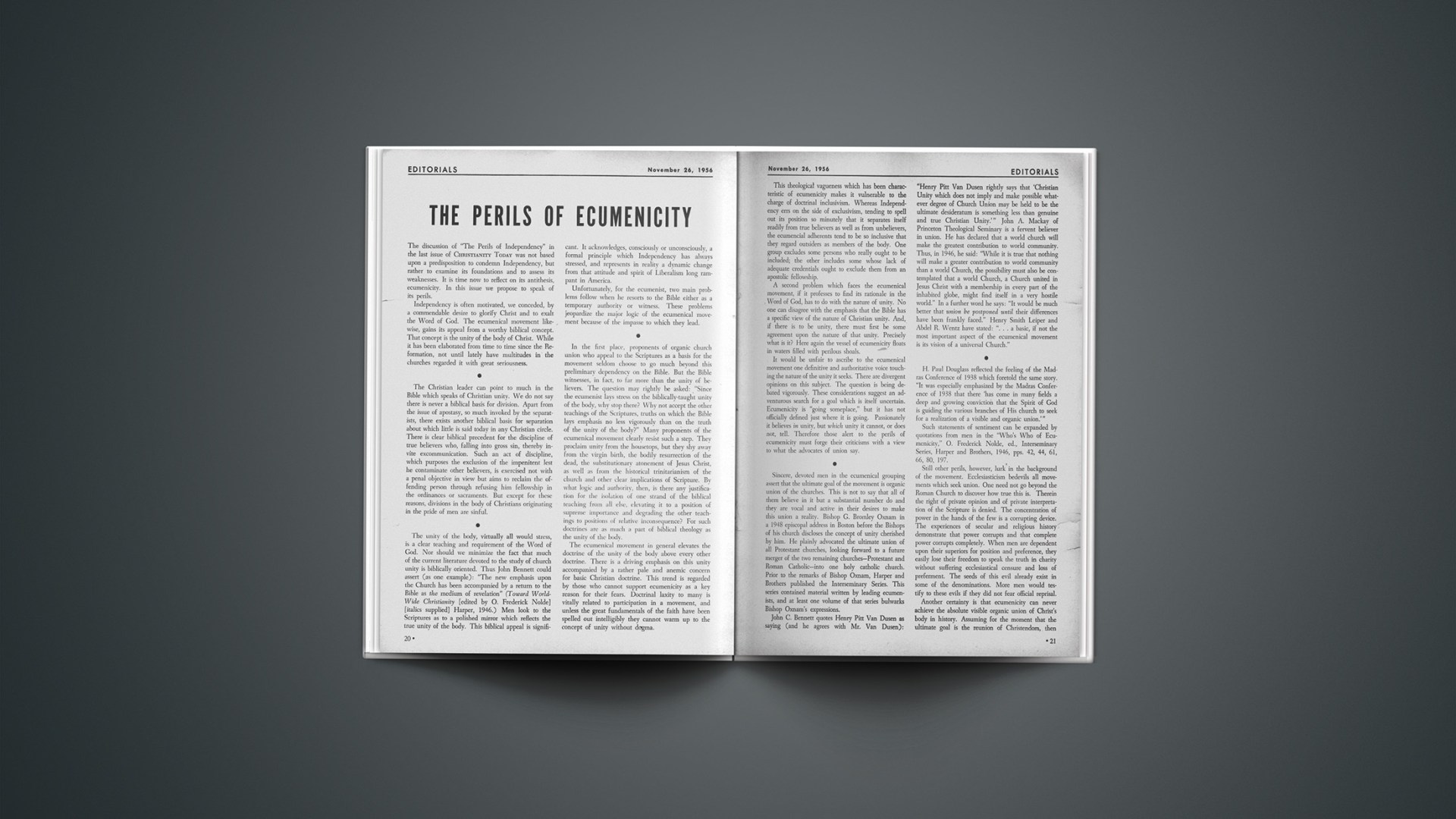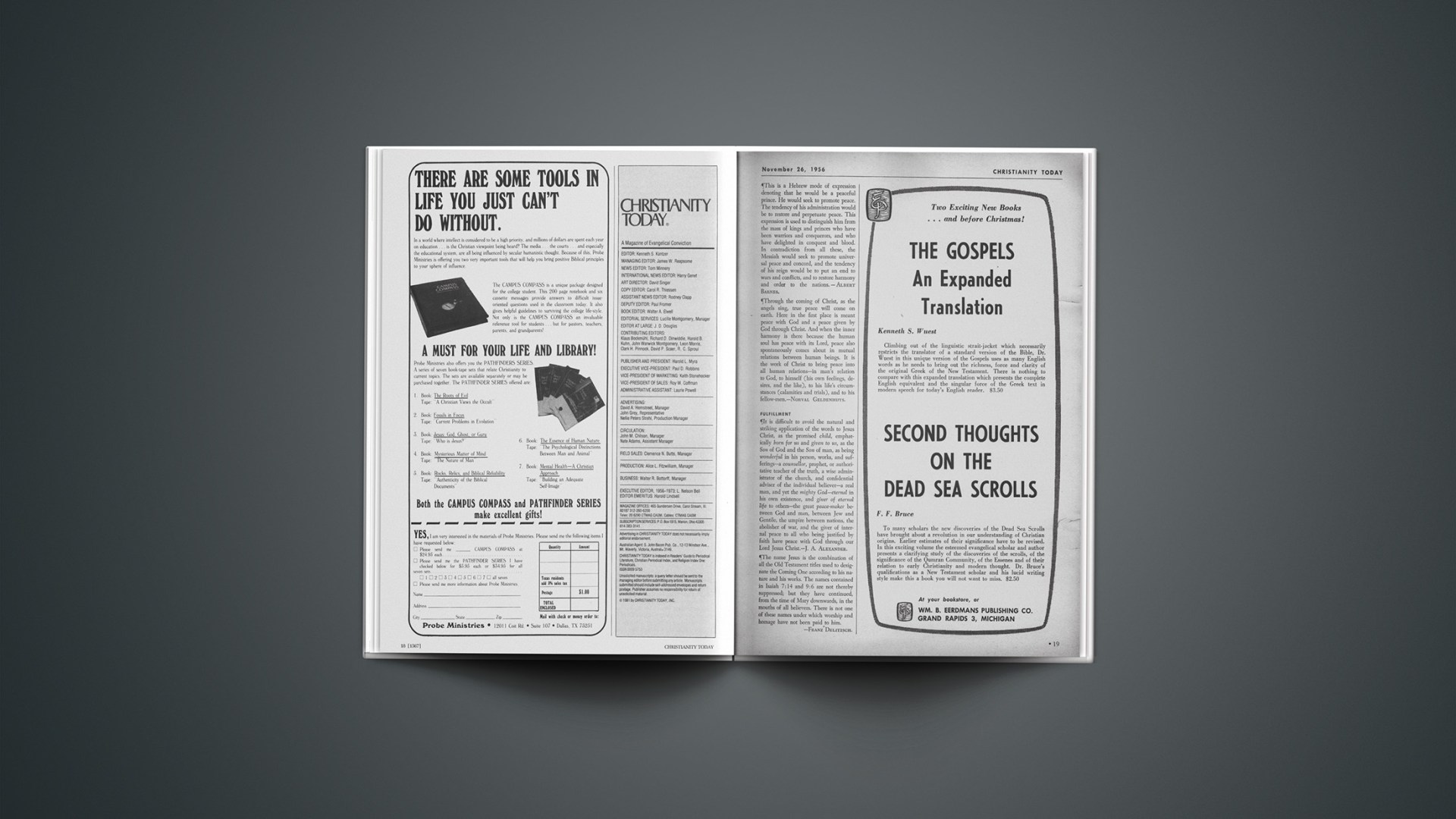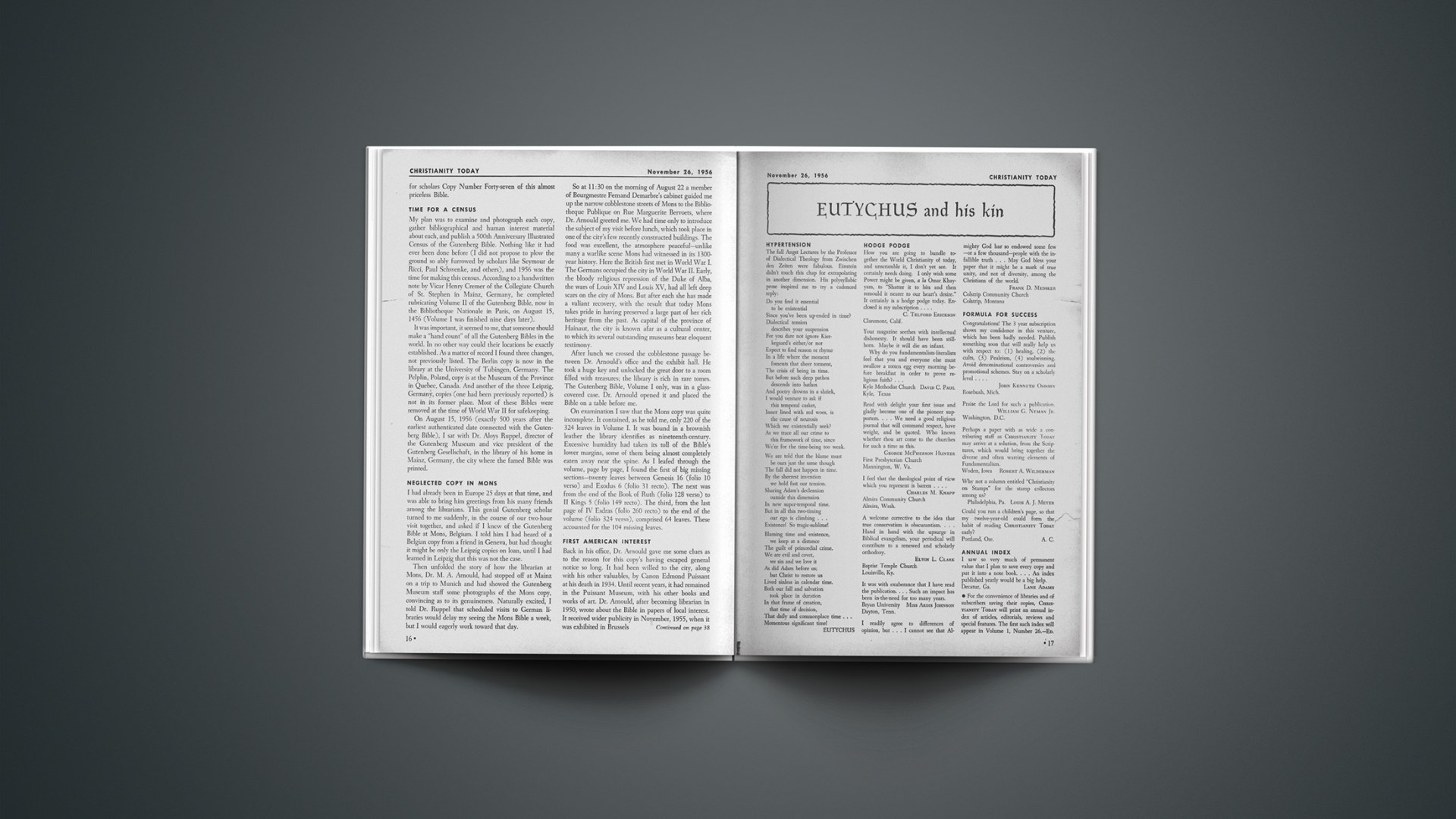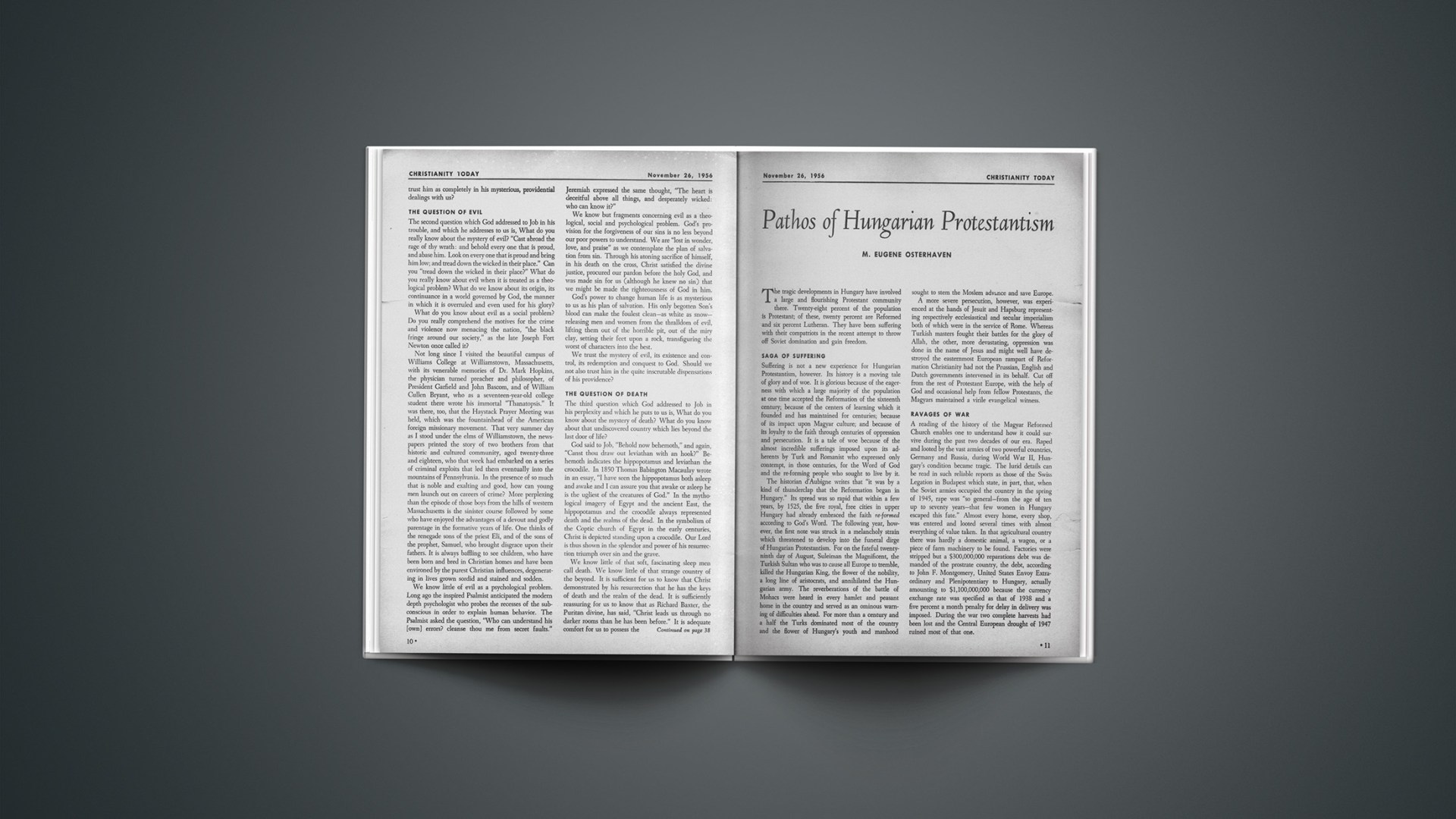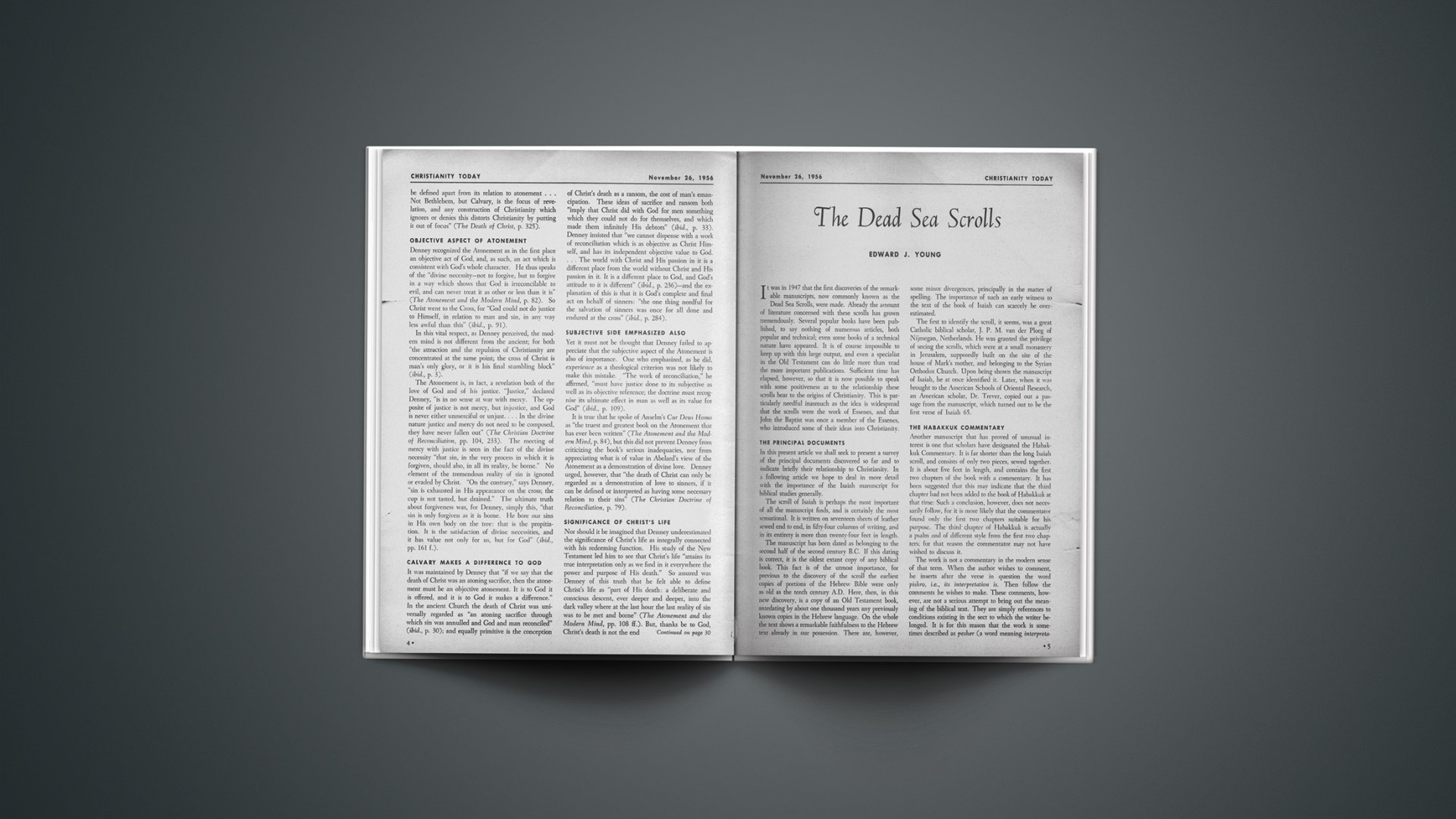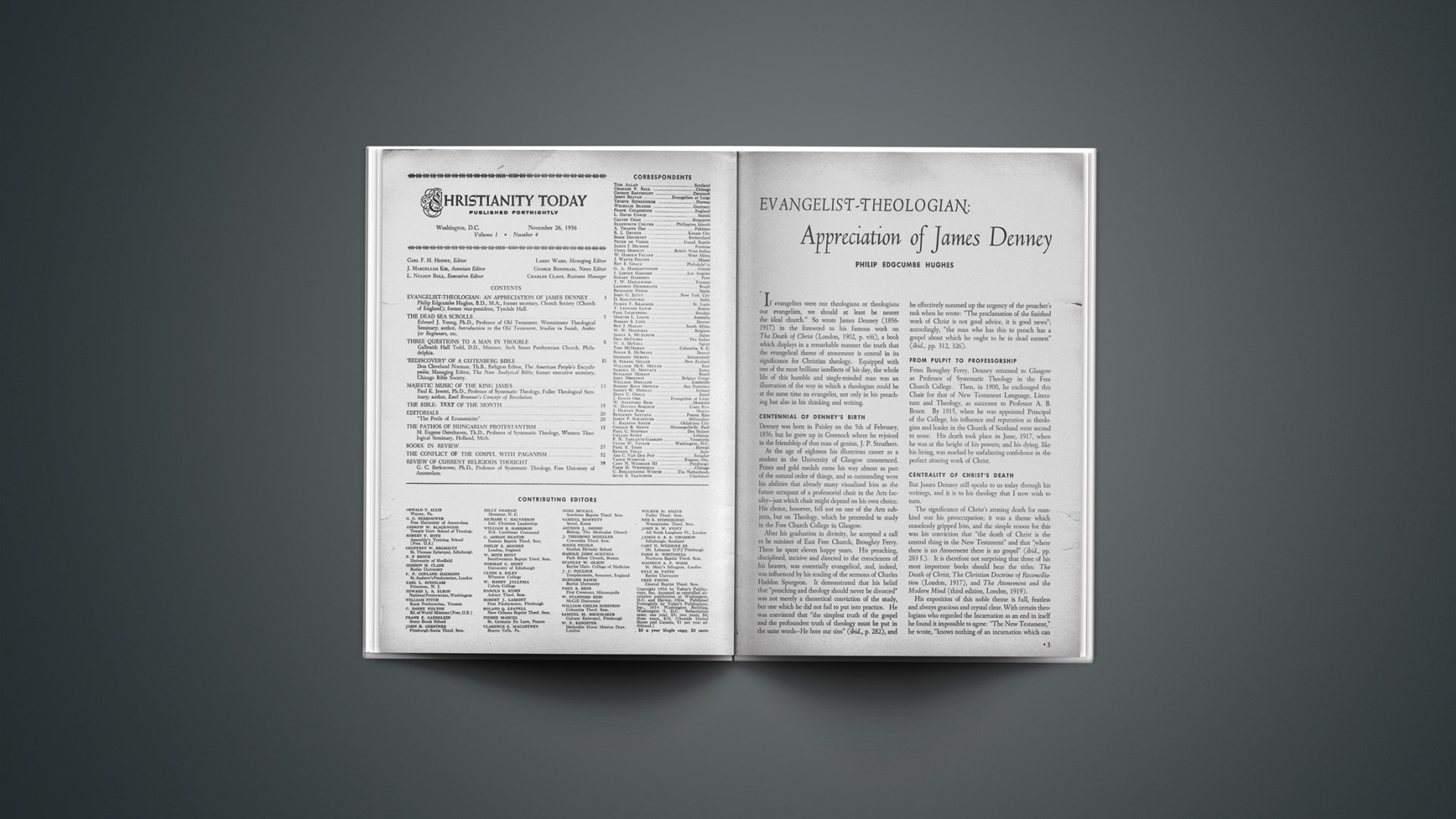Human Predicament
Christianity and the Existentialists, by Carl Michalson (editor). Scribner’s, New York, 1956. $3.75.
This book is made up of a very readable series of public lectures delivered at Drew University during the academic year 1953–54. Eight well-known scholars contribute as follows: Carl Michalson, editor, and Professor of Systematic Theology, Drew University, on “What is Existentialism?”; H. Richard Niebuhr, Professor of Theology and Christian Ethics, Yale Divinity School, on Soren Kierkegaard; John A. Mackay, President of Princeton Theological Seminary, on Miguel de Unamuno; Mathew Spinka, Professor of Church History, The Hartford Seminary Foundation, on Nicholas Berdyaev; J. V. Langmead Casserley, Professor of Dogmatic Theology, the General Theological Seminary, on Gabriel Marcel; Erich Dinkler, Professor of New Testament Literature, Yale Divinity School, on Martin Heidegger; Paul Tillich, University Professor, Harvard University on “Existentialist Aspects of Modern Art”; and Stanley Romaine Hopper, Dean of the Graduate School, Drew University, on “On the Naming of the Gods in Holderlin and Rilke.”
A certain arbitrariness in the selection of the existentialists under consideration was inevitable, as acknowledged by the editor, but as a service to the uninitiated, the book serves as a useful introduction to a philosophy made difficult not only because of its vocabulary and the importance of subjective moods of existentialists, but also because it is so contemporary. The aim of the book is further served well by the inclusion of a bibliography directing the beginning reader to additional sources.
Each writer sets out in brief compass some of the basic principles of the existentialist philosopher he is discussing, but it is not always apparent to the reviewer that the writers relate these to specifically Christian forms of thought and experience. In the opinion of the writer of this review, Professor Dinkler gives us the most explicit attempt in the latter by devoting twelve pages out of thirty to the relationship between Heidegger’s thought and Christian teaching. President Mackay’s essay on Michael de Unamuno proved to be the most vibrant of the book due first to Dr. Mackay’s personal acquaintance with Michael de Unamuno and Spanish life, and also the fact that for most of us this philosopher is a new figure.
After reading the book a Christian gets a sense of the acuteness of the problems of human existence in the face of the ultimate questions of human experience. Four of these stand out here, namely, the problem of guilt, the problem of communion, the problem of history and the problem of death. It is refreshing to find in these philosophers a disdain for the categories of Naturalism in terms of which an adjustment is sought to whatever happens to be the prevailing current in the cultural stream. It must be pointed out, however, that the contributors to this volume and especially the editor make clear the distinction between atheistic and metaphysical or theistic existentialism. Carl Michalson exhibits this contrast by the poignant use of an apt illustration from Kierkegaard. Man is shipwrecked at a point in the sea where the water is 70,000 fathoms deep. The atheistic existentialist suggests that man, in this predicament, will find his support in his thrashing about, whereas, the theistic existentialist will find his in the hope that while thrashing, his arms will encounter something outside himself for support.
Existentialism rubs the salt into the wounds of the human predicament, but where are the answers to the problems of human existence? One wonders whether answers are really possible within the framework of reference suggested in existentialism. For if as Heidegger writes, “… belief, not permanently exposing itself to the question and danger of unbelief, is no faith at all, but mere convenience and agreement with one’s self to keep the doctrine as to a comforting tradition” (p. 121), then the certainties of Christian experience based on justification by faith and union with Christ are not possible to the existentialist. If it is the prerogative of the existentialist to ask, but not to give, or find, answers to ultimate questions, then Paul Tillich is right in saying, “… I would agree that there is no Christian existentialism. There are many Christian existentialists; but insofar as they are existentialists they ask the question, show the estrangement, show the finitude and show the meaningless ness. Insofar as they are Christians, they answer these questions as Christians but not as existentialists” (p. 141). The assurances of genuine Christian experience will always prove a stumbling-block to philosophies not taking into account as final God’s intervention in history in redemption and the application of this by the Spirit in assured spiritual experience in the heart of the believer. No better expression of the problem of human existence on the one hand, and the resolution of the problem on the other, can be suggested than Augustine’s famous opening words in the Confessions, “Thou hast made us for Thyself, and our hearts are restless till they may have found their rest in Thee.”
SAMUEL J. MIKOLASKI
Divine Revelation
Exploring the Old Testament, by W. T. Purkiser. Beacon Hill, Kansas City. $4.50
Exploring the Old Testament comes as the answer to a need which has existed for a long time in the area of conservative scholarship for an introduction to Hebrew Scriptures at the undergraduate level. The panel of contributors to this work have sought to combine Old Testament introduction with the materials usually incorporated in Old Testament “book studies.” The editor has done his work so well that the volume gives no indication of its composite authorship nor of any essential differences of outlook among its writers.
A review of such a work can hope to do little more than indicate its general plan and to give its major characteristics. Sections 1 and 2 are basically introductory, dealing respectively with the themes, “This is God’s Word” and “Why the Old Testament?” These, along with Section 16, under title of “The Message and Meaning of the Old Testament” serve to acquaint the reader with the significance of the Old Testament for today’s Christian.
Sections 3 and 15 combine an analysis of the respective sections of the Old Testament with a survey of their meaning. These deal chronologically with Israel’s history, and after the events of 975 B.C. deal almost entirely with Judah’s history, except Section 11, “The Northern Kingdom and Its Prophets.” The volume includes two valuable appendixes, the first being designed to relate the chronology of the Old Testament to general world chronology; the second giving well-written summaries of the Old Testament books.
To characterize the work in detail would require more length than this book review permits. Some features, however, require special mention. First of all, Exploring the Old Testament is a good statement of the historic Christian position with reference to the Hebrew Scriptures. This statement is made from a generally affirmative approach, letting the Old Testament speak for itself and proclaim its own message. The writers show, however, an awareness of the critical problems which have been raised in connection with Old Testament studies and of the basics of so-called liberal Old Testament criticism. Its answer to the positions of liberal critical scholarship is two-told: that the Old Testament taken by itself fails to support these positions (i.e., that liberal criticism has forced its conclusions), and that the evidence for many liberal contentions is insufficient.
The volume embodies a valuable statement concerning such questions as the Old Testament canon, the versions and the New Testament use of the Old Testament. In addition to good basic statements upon these questions, there is an excellent bibliography by means of which the undergraduate teacher in biblical studies can expand the work of his classes as much as his program will permit and his needs will indicate.
The volume indicates an awareness upon the part of the writers of the significance of contemporary cultures for the understanding of Hebrew life and thought. The writers have a good knowledge of contemporary usages in Babylonian and Mesopotamian civilizations. Parallels in thought and practice are not minimized nor neglected by the writers, but rather, are shown for what they really were, namely survivals from an original disclosure of the Divine purposes—in fine, of an original Revelation.
The over-all impact of this work seems to this reviewer to be capable of summary in one word: appreciation. The writers have sensed the high significance of the Old Testament as divine Revelation. Their blend of comment and homiletics, their cross-referencing of Old Testament with the New Testament and their general attitude all work toward this objective. College student or intelligent layman will find this volume equally challenging. It is a significant addition to the literature of Bible-believing scholarship.
HAROLD B. KUHN
For Undergraduates
Exploring the New Testament, by Ralph Earle, Harvey S. Blaney, and Carl Hanson. Beacon Hill, Kansas City. $4.50.
This companion volume to Exploring the Old Testament is designed to meet a similar need, namely to be a “text for the required course in New Testament survey for lower division students in college.” Exploring the New Testament is similar in form to the earlier volume, seeking to compress the basics of New Testament introduction into three chapters, and then to expound in a topical order that which will reflect the general order of events described.
Chapter 1, “Why Study The New Testament?” is essentially hortatory: it seeks to inspire a love for the written Word and to cultivate an appetite for study of it. Questions of the extent and quality of inspiration are passed over briefly, with the emphasis being upon the message rather than the form of the New Testament Scriptures. This work then, assigns the home work for the study of apologetics rather than seeking to do its lessons for it.
The discussion of “The World Into Which The New Testament Came” (Ch. 2) seems unusually well-done; this reviewer would like to have had such an introduction to his undergraduate studies in New Testament. The same may be said of Chapter 3, “The New Testament Transmitted and Translated.” The writers have sought to broaden the base of New Testament study for undergraduates by filling the vacuum which the inter-testamental period seems too frequently to be.
The chapters dealing with the four Gospels present our Lord in a four-fold role: as Messiah-King, as Conqueror-Servant, as Son of Man and as Son of God. This division is, to be sure, not wholly original; but the manner in which the work of the four Evangelists is shown to present one outstanding portrait is unusual in books of this kind. The approach is affirmative; the writers indicate an awareness of modern liberal New Testament criticism, but in general take the approach that the interpretation of historic Christian faith presents the fewest problems, while many critical views are lacking in supporting evidence.
Taken together, the conclusions to the chapters dealing with Matthew, Luke and John (pp. 112; 185 ff.; and 224 ff.) afford an excellent over-all view of the events which tie together the Gospels and the remainder of the New Testament. From this, as well as from the manner in which parallel passages in the Synoptics are treated, the student can scarcely fail to gain the impression of “togetherness” which underlies the volume—and which is a wholesome relief from the excessive analysis which has plagued New Testament critical scholarship.
This same factor finds emphasis in the continuity which the writers trace in the several studies of the Acts of the Apostles, and of the Pauline, Johannine and Petrine literature. In a similar vein, the treatment of the Epistle to the Hebrews in the chapter “God’s Last Word to Man” (Ch. 13) pursues the method of relating the Old Testament to the New Testament and of discovering in both the Incarnate Word. The same may be said for the treatment of the Book of Revelation. Here the writer(s) treat with reserve the areas in which legitimate difference of opinion and interpretation exists among scholars, and lay emphasis upon the One who is revealed, and who stands supreme over angels, living creatures and elders.
The volume, Exploring the New Testament, maintains in fine balance a careful scholarly analysis and a spirit of reverent regard for the Lord and Mediator of the New Covenant. Historical and background materials are well written, and documented so far as is essential to keep the work in line with standard volumes of its kind. Footnotes are, in general, kept to a minimum.
This reviewer asked himself the question: Suppose that, prior to becoming acquainted with the New Testament itself, the book Exploring the New Testament came into his hands. What major thought would be in his mind as he read this work? The answer seems clearly this: Where can he secure a copy of
the New Testament of which Dr. Earle and his colleagues have written? To all who approach the matter in reverse, having first the New Testament, such a volume as this is of great value in making the Scriptures to be the object of earnest study.
HAROLD B. KUHN
Church In Politices
The Kingdom Without God, by Gerald Heard, Edmund A. Opitz and others, Foundation for Social Research, Los Angeles, 1956. The Powers That Be, by Edmund A. Opitz. Foundation for Social Research, Los Angeles, 1956.
Recently some laymen urged the union of two denominations because they would then be more able “to mold public opinion.” Their argument reflects the struggle being waged today to win support for ideas and causes.
But the laymen’s argument produces a disturbing question. What is the content of the Church’s message? Or to state it differently, what is the function of the Church’s voice?
As many evangelists see it, the Church is here to proclaim God’s saving grace in Christ and to teach all the things that He commanded. This teaching has many social implications, but it builds upon an individual experience of salvation. Regeneration occurs, then nurture and instruction. Since the proclamation of the Gospel is public, the world outside of Christ’s fellowship will be aware of Christian ideals and standards and will be affected by the attitudes and actions of faithful Christians in all areas of life.
There are many liberals in American Protestantism who construe the message and function of the Church differently. While in varying degree they may pay tribute to the need for individual salvation, they are engrossed in social improvement. To achieve this improvement, the Church must be expert in political and economic matters. Having decided on the best program available at the moment, the Church must have a powerful, united voice to sway public opinion. Then the Church depends upon the State to legislate and enforce the program.
Two booklets published by the Foundation for Social Research present the cleavage in American Protestant thought incisively. The larger booklet, “The Kingdom Without God,” bears the revealing subtitle, “Road’s End for the Social Gospel.” It contains essays by Gerald Heard, Edmund A. Opitz and others.
The essayists contend that the social gospel movement was “a first cousin to modern socialism” (p. i.). The older flag bearers were Washington Gladden and Walter Rauschenbusch; the newer ones, Reinhold Niebuhr, John C. Bennett, Liston Pope and Roswell P. Barnes. Social Action departments in the denominations and in the Federal Council of Churches were the centers of social gospel strategy. Their refuge and strength was in the enlarged use of government’s power according to their theories.
Mr. Opitz contributes more than others to the indictment of the social gospel movement and argues effectively for the “libertarian” case. “The role of governments is to protect individuals in their God-given individual rights” (p. 162). He deplores the popularity of the axiom that “political action, i.e., legalized violence, has an efficacy in human affairs far surpassing uncoerced, voluntary action” (p. 69). “Collectivism,” he avers, “in its many varieties, is the great secular faith of our time” (p. 78).
The other booklet, “The Powers that Be,” written exclusively by Opitz, presents case studies of the Church in politics. It exposes the one-sidedness of positions and pronouncements of the Federal Council and of its successor, the National Council of Churches, in questions concerning labor, the United Nations, and other economic and political issues.
The title page of both booklets lists the Foundation for Social Research “as a nonprofit corporation.” Its president is James C. Ingebretsen, 1521 Wilshire Boulevard, Los Angeles 17, California, at which address the booklets may be obtained.
CARY N. WEISIGER, III
Repentant Liberalism
Vocabulary of Faith, by Hampton Adams, Bethany, St. Louis. $2.50.
This little book, a series of popular messages on central Christian doctrines, could be mistakenly associated with the current revival of interest in the study of the theological key words of the Bible. In this respect the title is misleading.
Dr. Adams, distinguished pastor of Park Avenue Christian Church, New York City, teacher of courses in religion at New York City’s Union Theological Seminary and active representative of the Disciples of Christ in the ecumenical movement, confesses here a change in his own theological thinking (p. 113).
Against an apparent background of thorough-going liberalism, he now feels the language of the street cannot carry the Christian Gospel’s full weight of meaning (p. 7). In step with the repentant liberalism of today, he is ready to make fuller use of the once discarded vocabulary of faith.
On this basis the author proceeds in the course of 12 brief chapters, slanted particularly to the layman, to discuss such central doctrinal themes as: revelation, Christ, faith, God, the Holy Spirit, the atonement, reconciliation, redemption, resurrection, the Kingdom of God, the love of God, and grace. His point of departure in each instance is not the biblical witness but human experience, particularly the author’s own experience in counseling with those who “came to my study” (pp. 8, 9, 10, 23, etc.).
Some of the author’s ideas are: “Within their own experience, persons can have a positive revelation of God that is not traceable directly to God’s specific revelation” (p. 9); the early Christians called
Jesus Lord because “they could not believe in Jesus without believing in God” (p. 14); God is not to be thought of “as three separate, or even distinguishable, persons” (p. 52); faith that appropriates God’s forgiveness is “faith in God’s fatherhood that is inspired by Jesus’ death on the cross” (p. 64); we cannot be sure that anyone ever finally refuses to seek God’s forgiveness (p. 72); God’s forgiveness is “not an act but a quality of the love he gives to men” (p. 83); “many perhaps all, of the truest Christians have known themselves to be sinners ‘saved by grace’ ” (p. 116).
Although this is repentant liberalism, a chapter on sin is omitted.
Much could be said in appreciation of the book as far as it goes, particularly with reference to the author’s apologetic and his constant exposure of the inadequacy of contemporary secularism.
There are detracting oversights in printing: “Kupios” (p. 14), “authropos” (p. 27), “James S. Steward” (p. 51, f.n. 1), and “James Denny” (pp. 64 and 66, f.n. 1). There are inaccurate judgments: the Latin fathers are said to have written the historic creeds (p. 51); “nephesh” is said to indicate the principle of life which man as man possesses (p. 53); and a reference to the innate immortality of the soul is quoted without qualification (p. 92).
W. BOYD HUNT
Attractive Booklets
Booklets. American Tract Society, New York. 30c each.
These are five attractive booklets which a minister may desire to distribute to young Christians and others who desire knowledge of the subject treated. The first is “The Story of our Bible,” by Dr. David J. Fant. In simple and graphic form the study of the divine origin and growth of the Bible is told. Charts are given and there is a fine chapter on the scriptural portrait of Christ. The second booklet is, “The Spirit and Method of Bible Study,” by Dr. Wilbur M. Smith. This helpful booklet teaches the beginner how he may obtain the most out of the Scriptures. The third is a searching message to the minister titled, “Words to Winners of Souls,” by Horatius Bonar. This reveals the causes of an unfruitful ministry and indicates how one’s ministry may be enriched. The problem of prayer is dealt with in the fourth booklet, “Prayer,” by Dr. Samuel M. Zwemer. Along with suggestions regarding how to make prayer more effective, there is a brief exposition of the Lord’s Prayer. What to place in the hands of an inquiring Roman Catholic is sometimes a vexing problem. A fair presentation of the differences between Protestantism and Roman Catholicism is given in the fifth booklet, “Which Religion,” by Dr. George Wells Arms. It considers such doctrines as the Pope’s Infallibility, the Mass, Confessional, Indulgences, Purgatory and Mariolatry.
An Old Friend
A Dictionary of the Bible, by John D. Davis. Baker, Grand Rapids, Mich.
The Davis Dictionary of the Bible is not a new arrival but an old friend. It was in large measure the life work of Professor Davis who taught for many years at Princeton Seminary. The first edition appeared in 1898 and the fourth in 1924, about a year before Dr. Davis’ death. This fourth edition was reprinted seven times between 1924 and 1940; and it is a testimony to its enduring value that in 1954, thirty years after this edition appeared, the Baker Book House published this “photolith” reproduction which has been reprinted three times.
The reasons for the popularity of this Dictionary are briefly stated in the Preface to the original edition:
The book aims to be a dictionary of the Bible, not of speculations about the Bible. It seeks to furnish a thorough acquaintance with things biblical. To this end it has been made a compendium of the facts stated in the Scriptures, and of explanatory and supplementary material drawn from the records of the ancient peoples contemporary with Israel …
The serious defect in many of the books which have been written in recent years as “helps” to the study of the Bible has been that they have devoted too much time to theories about the Bible and have done this all too often for the purpose of imposing these theories upon the facts of the Bible. The facts remain the same; theories about them are often as ephemeral as they are various. Theories are discussed when it seemed advisable to do so. But they are distinctly secondary. It is also to be noted that Dr. Davis had the assistance of two of his distinguished colleagues at Princeton, Dr. George T. Purves and Dr. Benjamin B. Warfield.
Something should now be said about the second aim of Dr. Davis, to make the Dictionary a compendium “of explanatory and supplementary material drawn from the records of the ancient peoples contemporary with Israel.” It is quite superfluous to remark that archaeological research has made many and notable discoveries in the second quarter of the present century. Were Dr. Davis alive today he would make it his aim to incorporate them in what would be a fifth edition of the Dictionary. The present publishers have not deemed it advisable to revise the Dictionary in order to bring it up to date archaeologically. As to this two things are to be noted. The one is that the discoveries of the archaeologist, important and valuable as they are, concern the background and setting of Biblical history. They add nothing to the Biblical revelation per se. Helpful as they are in many ways they serve rather to show the vast difference between the religion of Israel and the religions of the peoples with which Israel came in contact. Furthermore, it must be remembered that many of the findings of archaelogy are inconclusive, that while it has solved some problems it has raised many others. The scroll of history which it unrolls before us is in many respects more obscure and fragmentary than we often realize.
Fifty years ago there were two main theories as to the date of Exodus. The one made Thothmes III the Pharaoh of the oppression, the other Rameses II, a difference of about two centuries. Dr. Davis advocated the later date, holding it to be in harmony with the facts given in the Bible. Other scholars held then and hold today that the earlier date is more probable. The question is much debated today. Many critical scholars hold that only a few of the Twelve Tribes ever were in Egypt, and the Conquest took place at several different times and from more than one direction, a view which is utterly incompatible with the facts stated in the Bible.
The distinction drawn by Dr. Davis between facts and theories is an important one. The Christian rejoices in every confirmation and illumination of the statements of the Bible which archaelogy has produced. But he does not accept these statements because the archaeologist tells him that he may do so, but because they are found in the Bible. And conversely he feels fully justified in rejecting the findings of the scientists when they contradict the statements of Scripture. Consequently, while we may regret that the archaeology of the Dictionary is not fully abreast of the clearest finding of the archaeologist, we welcome it and value it because it is primarily a dictionary of the Bible and not of speculations about the Bible and because a multitude of users have found its interpretations to be “sober, fair, and just.”
OSWALD T. ALLIS

